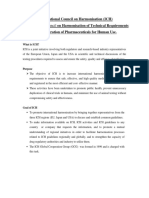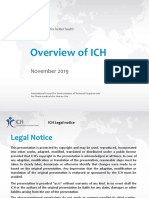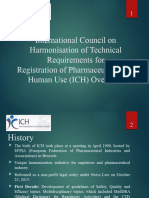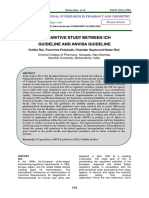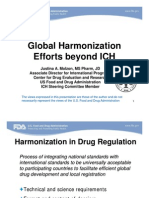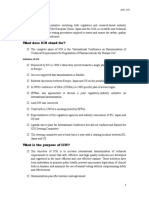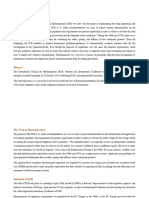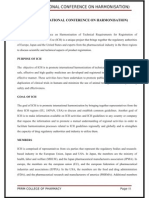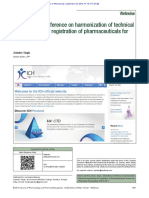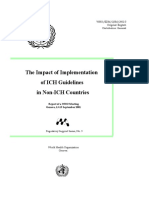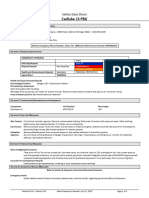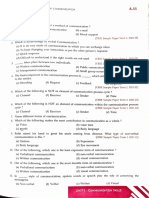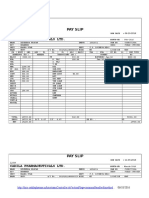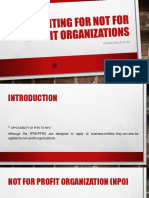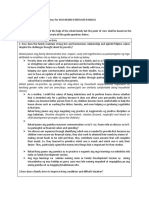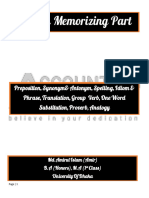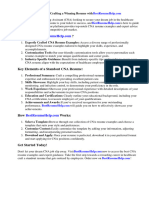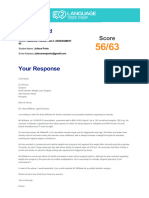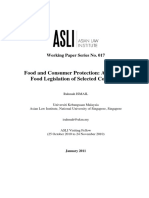June 2015
INTRODUCTION TO ICH
ICH stands for "International Conference on Harmonisation of Technical Requirements for
Registration of Pharmaceuticals for Human Use".
ICH’s logo has been designed with a view to representing the letters "I", "C", "H" in a manner
which embodies the letters in an abstract human form. The principle colour of the logo is blue, a
colour often synonymous with healthcare, and which adds an air of vitality and wellbeing to the
depicted abstract figure. Purple was chosen as being complementary to blue.
1. Mission
ICH’s mission is to make recommendations towards achieving greater harmonisation in the
interpretation and application of technical Guidelines and requirements for pharmaceutical
product registration.
Harmonisation is achieved through the development of ICH Guidelines.
2. History
Since ICH's inception in 1990, the ICH process has gradually evolved.
ICH's first decade saw significant progress in the development of ICH Guidelines on Safety,
Quality and Efficacy topics. Work was also undertaken on a number of important
multidisciplinary topics, which included MedDRA (Medical Dictionary for Regulatory
Activities) and the CTD (Common Technical Document).
During the second decade, the development of ICH Guidelines continued, but with more
attention given to the need to:
Maintain already existing Guidelines as science and technology continued to evolve;
Expand communication and dissemination of information on ICH Guidelines with
other regions;
Facilitate the implementation of ICH Guidelines in the ICH regions;
Coordinate with other organisations, particularly for the development of electronic
standards.
In its third decade of activity, ICH's attention is directed towards extending the benefits of
harmonisation beyond the ICH regions. Training, as well as active participation of other regions
in Guideline development is seen as key in this effort.
1
� Introduction to ICH
3. Organisation
a. ICH Steering Committee and its sub-groups
Figure 1: ICH structure
The ICH structure consists of the ICH Steering Committee (SC), ICH Coordinators, ICH
Secretariat and ICH Working Groups. The ICH MedDRA Management Board is a sub-
committee of the ICH SC (Figure 1). In June 2013, the Global Cooperation Group (GCG) format
was modified. A recast “GCG session” was incorporated into a standing agenda item of the ICH
SC agenda entitled Global Cooperation (GC). Other countries (Regional Harmonisation
Initiatives (RHIs) and individual Drug Regulatory Authorities and Department of Health
(DRAs/DoH) are invited to participate in the GC session of the ICH SC meeting.
The ICH SC and its MedDRA sub-committee are comprised of representatives from all ICH
Parties which are described as follows:
Regulatory ICH Parties:
Europe: the ICH Regulatory Party is represented by the European Commission (EC) and
the European Medicines Agency (EMA);
Japan: The ICH Regulatory Party is the Ministry of Health, Labor and Welfare (MHLW)
and the Pharmaceuticals and Medical Devices Agency (PMDA);
USA: The ICH Regulatory Party is the Food and Drug Administration (FDA);
Canada: The ICH Regulatory Party is the Health Products and Food Branch (HPFB);
Switzerland: The ICH Regulatory Party is the Swissmedic.
Industry ICH Parties:
Europe: the European Federation of Pharmaceutical Industries and Associations (EFPIA);
Japan: The Japan Pharmaceutical Manufacturers Association (JPMA);
2
� Introduction to ICH
USA: the Pharmaceutical Research and Manufacturers of America (PhRMA).
WHO, the ICH Observer, has been associated with the ICH process from the beginning to act as
a link with countries and regions beyond ICH. WHO is a non-voting member who is part of the
ICH SC.
The International Federation of Pharmaceutical Manufacturers & Associations (IFPMA) which
has been closely involved with ICH since its inception participates also as a non-voting member.
Figure 2: ICH SC composition
b. ICH Expert Working Groups (EWGs) / Implementation Working Groups (IWGs)
Each of the ICH Parties (EU, MHLW/PMDA, FDA, Health Canada, Swissmedic, EFPIA,
JPMA, PhRMA) and the ICH Observer (WHO) nominate official representatives to each ICH
Working Group. The official membership of EWG/IWG shall be comprised of one Topic Leader
and one Deputy Topic Leader for ICH Parties and one representative per ICH Observer. Experts
are nominated by the ICH regional Coordinators.
Experts from Regional Harmonisation Initiatives (RHIs), Drug Regulatory Authorities (DRAs)
and Department of Health (DoH) participating in ICH activities are invited to nominate one
expert to participate in all ICH Working Groups (WGs).
Depending on the topic under harmonisation, other experts may also be invited by the ICH SC to
nominate one representative to participate in WGs: if approved by the SC, one expert can be
invited from: ICH Regional Pharmacopeias and ICH Interested Parties (World Self-Medication
Industry - WSMI, International Generic Pharmaceutical Alliance - IGPA, Biotechnology
Industry, International Pharmaceutical Excipients Council – IPEC, Active Pharmaceutical
Ingredient Industry – API and Pharmaceutical Inspection Co-operation Scheme – PIC/s).
4. Work products
3
� Introduction to ICH
Guidelines: ICH has developed over 60 harmonised Guidelines aiming at eliminating
duplication in the development and registration process, so that a single set of studies can be
generated to demonstrate the quality, safety and efficacy of a new medicinal product.
ICH has also developed Questions and Answers (Q&As) when additional guidance and advice
were considered necessary to help the interpretation of some harmonised Guidelines.
CTD: The Common Technical Document (CTD) describes the common format for the
preparation of a well-structured CTD for applications that will be submitted to regulatory
authorities.
eCTD: The electronic Common Technical Document (eCTD) has been developed for the
electronic submission of the Common Technical Document from applicant to regulator, in order
to facilitate international electronic communication through the provision of Electronic Standards
for the Transfer of Regulatory Information (ESTRI).
MedDRA: The Medical Dictionary for Regulatory Activities (MedDRA) terminology has also
been developed under the auspices of ICH.
Consideration documents: The Consideration documents have been developed by discussion
groups i.e., Gene Therapy Discussion Group, and ICH & Women Discussion Group to report
specific scientific considerations.
5. Strategy on Training and Capacity Building
The ICH SC recognises the importance of training in helping to facilitate the implementation of
ICH Guidelines both in its own regions and beyond.
ICH regions: The need for oversight on training with respect to ICH Guidelines is generally left
to each region’s discretion, except for MedDRA, where the ICH MedDRA Management Board
oversees the provision of training to MedDRA subscribers worldwide. The SC acknowledges
that from time to time there is benefit in coordinating training activities so as to ensure
consistency in the manner in which Guidelines are implemented, particularly where new and
complex concepts are introduced.
Other ICH regions: There is an increasing interest from countries beyond ICH regions in the
utilisation of ICH Guidelines, and as a consequence, training and capacity-building have become
a key focus of the ICH Global Cooperation session of the SC meeting.
6. Process of harmonisation
The ICH SC is responsible for the governance of ICH. This includes deciding on the adoption of
every ICH project, whether a new topic, maintenance of an existing Guideline, or a specific
implementation work.
Each harmonisation activity is initiated by a Concept Paper which is a short summary of the
proposal. Depending on the category of harmonisation activity a Business Plan may also be
4
� Introduction to ICH
required.
Any ICH Party or the ICH Observer is welcomed to submit a proposal for a new ICH activity.
ICH harmonisation activities fall into 4 categories: Formal ICH Procedure, Q&A Procedure,
Revision Procedure and Maintenance Procedure.
a. Formal ICH Procedure
A formal ICH procedure is initiated with the endorsement by the SC of a Concept Paper and
Business Plan. An Expert Working Group (EWG) with membership as specified by the Concept
Paper is subsequently established. At the same time, a Rapporteur (and co-Rapporteur) is
officially designated by the SC and a Regulatory Chair is officially designated the by the
regulatory parties of the SC. The EWG works to develop a draft Guideline and bring it through
the various steps of the procedure which culminate in Step 5 and the implementation in the ICH
regions of a harmonised Guideline.
Figure 3: Various Steps of a formal ICH procedure
Step 1: Consensus building: The process of consensus building begins when the ICH SC adopts a
Concept Paper as a new topic. Step 1 is initiated when the EWG begins the preparation of a
consensus draft of the technical document, based on the objectives set out in the Concept Paper.
Work is conducted via e-mail, teleconferences and webconferences. If endorsed by the SC, the
EWG will also meet face-to-face at the biannual SC meetings. Interim reports on the progress of
the draft technical document are made to the SC on a regular basis.
When consensus is reached among EWG members from all ICH Parties, the EWG will sign the
Step 1 Experts sign-off sheet. The Step 1 Technical Document with EWG signatures is then
submitted to the ICH SC to request adoption under Step 2a of the ICH process.
Step 2a: Confirmation of consensus on the Technical Document: Step 2a is reached when the
ICH SC agrees based on the report of the EWG, that there is sufficient scientific consensus on
the technical issues for the Technical Document to proceed to the next stage of regulatory
consultation. The consensus text approved by the experts under Step 1 is signed-off by the SC as
the Step 2a Final Technical Document.
5
� Introduction to ICH
Step 2b: Adoption of the draft Guideline: On the basis of the technical document, the Regulatory
ICH Parties will take the actions they deem necessary to develop the “draft Guideline”. The
consensus text is signed-off by the SC Regulatory ICH Parties as Step 2b Draft Guideline.
Step 3: Regulatory consultation and Discussion: Step 3 occurs in three distinct stages:
o Stage I: Regional regulatory consultation: The Guideline embodying the scientific
consensus leaves the ICH process and becomes the subject of normal wide-ranging
regulatory consultation in the ICH regions. In the EU it is published as a draft CHMP
Guideline, in Japan it is translated and issued by MHLW for internal and external
consultation, in the USA it is published as draft guidance in the Federal Register and in
Canada it is posted on the Health Canada website to solicit comments.
Regulatory authorities and industry associations in other regions may also comment on
the draft consultation documents by providing their comments to the ICH Secretariat.
o Stage II: Discussion of regional consultation comments: After obtaining all comments
from the consultation process, the EWG works to address the comments received and
reach consensus on what is called the Step 3 Experts Draft Guideline. If the Rapporteur
was from an industry party, until Step 2b a new Rapporteur from a regulatory party is
appointed, preferably from the same region as the previous Rapporteur. The same
procedure described in Step 1 is used to address the consultation results.
o Stage III: Finalisation of Step 3 Experts Draft Guideline: When, after due consideration
of the consultation results by the EWG, consensus is reached amongst the experts from the
ICH Parties on a revised version of the Guideline, the Step 3 Experts Draft Guideline is
signed by the EWG experts of the Regulatory ICH Parties. The Step 3 document with
regulatory EWG signatures is submitted to the SC to request adoption at Step 4 of the ICH
process.
Step 4: Adoption of an ICH Harmonised Guideline: Step 4 is reached when the ICH SC
agrees, on the basis of the report from the Regulatory Chair and the Rapporteur of the EWG, that
there is sufficient consensus on the draft guideline. Step 4 is reached when the document is
signed-off by the SC Regulatory ICH Parties as an ICH harmonised Guideline.
Step 5: Implementation: Having reached Step 4, the harmonised Guideline moves immediately
to the final step of the process that is the regulatory implementation or Step 5. Step 5 is carried
out according to the same national/regional procedures that apply to other regional regulatory
guidelines and requirements, in the EU, Japan, USA, Canada and Switzerland.
b. The Q&As Procedure
6
� Introduction to ICH
The Q&As procedure is followed when additional guidance is considered necessary to help the
interpretation of certain ICH harmonised Guidelines and ensure a smooth and consistent
implementation in the ICH regions and beyond.
The procedure is initiated with the endorsement by the SC of a Concept Paper (a Business Plan
may be required in certain cases). An IWG is nominated to work on a draft Q&A document. The
group makes a recommendation to the SC on whether the document would require a public
consultation (Step 3 of the ICH process) based on the level of information provided by the
answers.
The document then follows the normal path of a Step 2b/Step 4 document as per the Formal ICH
Procedure.
c. The Revision Procedure
The revision procedure is followed either in cases where the scientific/technical content of an
existing ICH Guideline is no longer up-to-date or valid, or in cases where there is new
information to be added with no amendments to the existing ICH Guideline necessary. In the
case of the latter, the new information can be added in the form of an Addendum (or an Annex in
the case of Q4B) to the Guideline.
The procedure is initiated with the endorsement by the SC of a Concept Paper. For revisions a
Business Plan is not necessary. An EWG with membership as specified by the Concept Paper is
subsequently established.
The revision procedure is almost identical to the Formal ICH Procedure i.e. 5 ICH Steps. The
only difference is that the final outcome is a revised version of an existing Guideline, rather than
a new Guideline.
The revision of a Guideline is designated by the letter R1 after the usual denomination of the
Guideline. When a Guideline is revised more than once, the document will be named R2, R3,
R4, etc at each new revision. In cases where an Addendum has been developed, upon reaching
Step 4 the Addendum is added to the existing Guideline.
d. The Maintenance Procedure
The Maintenance Procedure is currently applicable only for changes to the Q3C Guideline on
Impurities: Residual Solvents and M2 Recommendations. In each case the procedure is used
when there is new information to be added or the scientific/technical content is out-of-date or no
longer valid.
7. ICH meetings
7
� Introduction to ICH
The ICH SC meets on a biannual basis during a week which has the participation of other
regulatory members (RHIs and DRAs/DoH) and which also includes meetings of the ICH
MedDRA Management Board. Also occurring on the ICH week is the International
Pharmaceuticals Regulatory Forum (IPRF), which has participation from both ICH regulators
and other regulatory members of the GC. These meetings run in parallel of meetings of ICH
technical working groups.
Any ICH technical working group face-to-face meeting is subject to decision by the ICH SC.
With a view to keeping down organisational and logistical costs of the ICH Process, WGs should
meet face-to-face only when necessary and justified in their work plan and when sufficient
discussion materials are available.
In order for face-to-face meetings to be considered official, all ICH Parties need to be
represented in all parallel meetings, at least by one delegate.
Saturday Sunday Monday Tuesday Wednesday Thursday
ICH MedDRA ICH
Management IPRF IPRF Steering ICH Steering Committee
Board Committee
ICH Technical Working Groups
Figure 4: ICH week normally adheres to the same schedule of meetings, commencing on Saturday with the ICH
MedDRA Management Board meeting and finishing on Thursday with the ICH SC meeting. These meetings run in
parallel of meetings of ICH technical working groups.
Onsite, the ICH Secretariat and the Host organiser provide administrative support to all
participants to ensure the smooth running of all meetings (e.g., daily update of meeting schedule,
document sign-off, presentation printing).
8. In between meetings
ICH SC: Ahead of the ICH week, the ICH Secretariat organises teleconferences with the ICH
SC, Coordinators, MedDRA Management Board and Global Cooperation members to prepare
for their respective meetings and raise any issues to be addressed at the meetings. At its
teleconference, the SC should reach agreement on which Working Groups will meet at the face-
to-face meeting.
Between face-to-face meetings ICH EWGs/IWGs are encouraged to make use of modern
communication technologies (e-mail, webconferences, teleconferences, etc.) to progress draft
Guidelines. In order for teleconferences/webconferences to be considered official, all ICH
Parties need to be represented, at least by one delegate.
8
� Introduction to ICH
Working groups could also meet outside the regular ICH SC weeks. These Interim face-to-face
meetings have to be endorsed by the ICH SC and take place exceptionally only when there is an
absolute necessity in order for the topic to meet its assigned objectives in time.
ICH Coordinators designated by each of the ICH co-sponsors and Focal Points nominated by
RHI/DRA/DoH representatives, play a fundamental role in smooth running of ICH.
Their role includes to act as the main contact point with the ICH Secretariat and to ensure that
any ICH documents are distributed to the appropriate persons within the area of their
responsibility (e.g., meeting announcement, registration forms)
In addition to providing support to the ICH SC, the ICH Secretariat is primarily concerned with
preparations for, and documentation of, meetings of the SC as well as coordination of
preparations for Working Group meetings.
